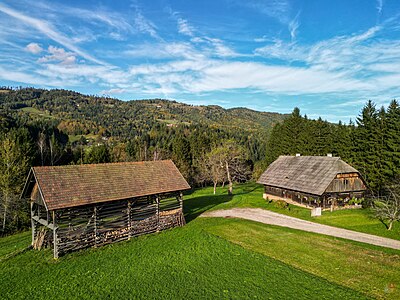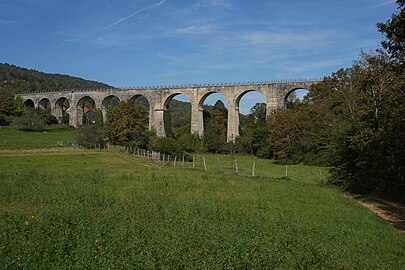Commons:Wiki Loves Monuments 2023 in Slovenia
Wiki Loves Monuments is an international photographic competition to promote historic sites around the World through Wikimedia projects (mainly Wikipedia and Wikimedia Commons). Everybody can participate.
The goal of Wiki Loves Monuments is to encourage people to take pictures of cultural monuments near them, and to put them under a free licence so that they are shared with the world through the Internet. To achieve that, an international contest will take place in October 2023. We will explain below how to participate. There are also dozens of other countries that you can participate in, please check out the international website.
Participate
The competition is now closed. Thank you to all the contributors!
Winners
Special mention
-
Kresija palace and Filip mansion, Ljubljana
Author: Petar Milošević -
Otovec railway bridge
Author: Manca Filak -
Ladejek farm
Author: Foonzzi -
St. Eligius chapel, Kamnik
Author: Krzysztof Golík -
Ptuj with Ptuj castle
Author: Krzysztof Golík -
Triple bridge and Prešeren Square, Ljubljana
Author: Petar Milošević -
Immaculate Conception church, Kamnik
Author: Krzysztof Golík
Take photos
Describe them
Upload to Commons
Contact us!
Slovene part of the competition is organized by the Wikipedians of Slovenia User Group. For any questions, you can contact us at this page's talk page. The main organizer, Jernej Polajnar, is also reachable at jpolajnar.wiki![]() gmail.com.
gmail.com.
Why participate?
Participate in Wiki Loves Monuments, the largest photography competition in the world, and help Wikipedia document monuments and heritage buildings.
Participating is fun! By photographing and sharing images of heritage nearby you, you can explore more about Slovene heritage around you and learn about it! It's a good challenge to improve your photography skills, and you can of course win some nice prizes. The national jury will select up to 10 images that will represent Slovenia in the international finale. These images will compete for the international awards. More information about the international competition is available on wikilovesmonuments.org.
You can also upload images that you may have taken already during one of your travels to the national competition of that country. Check if your travel destination participates in Wiki Loves Monuments this year.
Competition rules
We try to keep the competition clean and simple to participate. There are only a few rules for photos to participate in the contest in Slovenia. Let's quickly go through them. Every submission should be:
- Self taken and self uploaded;
- Uploaded during October 2023;
- During the upload process, you give permission with a CC BY-SA license to re-use the image;
- Contain a listed monument, which you have identified using the monument identifier (see elsewhere on this page);
Next to that, there are a few practical rules:
- You should have an activated e-mail address on Wikimedia Commons;
- If the photo gets deleted for any reason, it is automatically disqualified from the competition;
- You are responsible for following the law while taking and uploading the photo.
The organizers may contribute, but are not eligible for awards.
Prizes
Prizes for winners include:
 place: a day with restorers of the Institute for the Protection of Cultural Heritage of Slovenia (ZVKDS)
place: a day with restorers of the Institute for the Protection of Cultural Heritage of Slovenia (ZVKDS) place: book prize by ZVKDS
place: book prize by ZVKDS place: book prize by ZVKDS
place: book prize by ZVKDS
Where are the monuments?
Full list of monuments is available through the Cultural Heritage Registry browser, but note the requirements and legal issues. You can also consult selection of monuments by region. More info below.
The Jury
Contributions will be evaluated by a three-member jury:
- Matjaž Zaplotnik, wikipedian
- Damjana Pečnik (ZVKDS)
- Nina Grein, photographer
Judging criteria
The local jury will determine the winners taking into the consideration the following criteria:
- Technical quality (sharpness, use of light, perspective etc.);
- Images below 2 megapixels size (e.g. 1600×1250) will not be considered;
- Originality;
- Usefulness of the image for Wikipedia, meaning:
- the monument is clearly and comprehensively depicted, usable in an infobox in the article about the monument on Wikipedia, or in a subsection about one of its details;
- depiction of a monument for which few or no images exist on Wikimedia Commons already (you can check that by searching for it).
Slovene jury will select up to 10 best contributions in November and submit them to represent in the international finale. The international jury will then announce the international winners in early 2023.
Images that reach a top ranking of the international finale will typically at least fulfill the Featured pictures criteria at Wikimedia Commons. But feel free to submit many images, and let the jury be concerned if they are good enough. Even average-quality photographs will help Wikipedia.
Supported by

Local organizer
Wikipedians of Slovenia User Group:
- Jernej Polajnar (organizer)
- Matjaž Zaplotnik (head of jury)
- Vera Pelhan (organizational support)
Other support
- Institute for the Protection of Cultural Heritage of Slovenia (jury, sponsorship)
- Nina Grein, photographer (jury member)
Sponsors
Monuments in Slovenia

The official list of monuments is maintained by the Slovene Ministry of Culture, and accessible through the Cultural Heritage Registry browser (Slovene only). Entries with the labels »spomenik lokalnega pomena« (monument of local significance), »spomenik državnega pomena« (monument of national significance) and »neznano« (unknown listing type) are eligible for this competition. Many other objects in the registry do not have this information, those are »registered objects« without an official monument status, and not eligible for this competition.
To help with locating and uploading, we also prepared a selection of monuments by region (Slovene only). Those lists feature handy upload buttons with preentered data about names and locations.
There is no Freedom of panorama in Slovenia, meaning that we aren't allowed to freely share photographs of objects that are still copyrighted. Copyright expires 70 years after the author's death. This issue is explained below.
The copyright issue
Important: if you pick a monument in the RKD browser which isn't on our lists, make sure that its creators died in 1953 or earlier. Likewise, »orphaned works« without known authors created before 1953 are not eligible. The Wikimedia Commons community dilligently patrols the contributions and deletes ones without a clear copyright status. In case of doubt, we suggest to stick with our lists which have been filtered to exclude copyrighted works.
Freedom of panorama
Some other countries are more liberal, among those are most of the Central European states with full freedom of panorama. This issue is explained in detail on Commons:Freedom of panorama.
Where are all the WWII memorials? Where is Plečnik!? The issue of copyright.
Buildings and 3-D creative works such as statues are intellectual creations protected by copyright law; in Slovenia, this is covered by the Copyright and Related Rights Act (Slovene: Zakon o avtorski in sorodnih pravicah, or ZASP). The author has the exclusive right to exploit and reproduce images of his works. When we photograph it, the photograph is a so-called derivative work. It is subject of both the depicted object author's copyright, as well as the photographer's copyright (a photo is an intellectual creation in terms of choice of composition, lighting etc.). ZASP introduces in article 55 an exception for works that are permanently placed in publicly accessible premises – images of those are free, but not in 3-D form and not commercially. This exception is called Freedom of panorama.
Wikimedia Commons only accepts works that are published under a free license which permits anybody to reproduce and use them for any purpose, including commercially. For this reason, we are not allowed to upload photos of copyrighted objects, because their copyright owners would have to explicitly agree with the free license. In other words, Slovenia does not have sufficient freedom of panorama. Copyright runs until 70 years after the author's death, so for example even the works of Slovenia's most prominent architect Jože Plečnik (1872–1957) won't be free until 2028.












